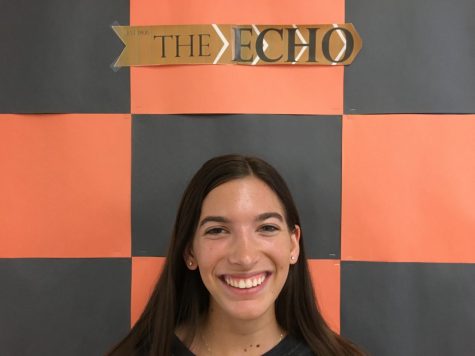The American Scholar vs. The American Student
June 4, 2018
“COME JOIN OUR WALKOUT! 12 p.m. in the parking lot. Stand with us and be a voice for change!”
This message shows up as Skylar scrolls through her Facebook. The app informs her that 107 of her friends will be attending this event. As she clicks to open the post for further investigation, she wonders about the purpose of the event. Skylar ponders what could be so important that students feel the need to interrupt school and what “change” is intended to occur.
Skylar’s classmate, Steve, encounters this same post on his own Facebook account. Upon reading that 107 of his same Facebook friends will also be attending, he clicks the “will be attending” button right away. He scrolls through the 34 comments and feels obliged to add one. Steve examines what other people have written to help him choose the most appropriate phrase to write. He decides to post this routine, insincere comment: #StandTogether.
Both Skylar and Steve end up going to the event. In the parking lot that Friday, Steve can be found with his group of friends, posing with patronizing posters plastered with phrases pasted directly from the Facebook comments section. As the speakers are giving their speeches up on the risers, you can spot Steve looking down at his phone, editing the photo he has chosen to post about the event. He does not really know or care all that much about the cause that the event is supporting. All he knows is that “walkout” seems to be the buzzword of the day, and so this event belongs on his social media page. When the likes stop rolling in and eventually come to a screeching halt, so does Steve’s memory of the walkout event.
On the other hand, Skylar does not take any pictures before the event begins. She stands patiently, waiting. Listening intently to the speech given at the podium, she absorbs all the information she can. The speaker encourages the crowd to “speak out” and “write to your congressman,” but there is no mention of the substance to be included in these writings to Congress. As she heads back to class after the conclusion of the event, she asks her friends’ opinions of the message that was conveyed that afternoon. They all parrot the same narrative, which undoubtedly shines with optimism. To Skylar’s chagrin, her friends lack the background knowledge to support their claims about the issue.
Skylar realizes that she, too, does not have all the answers. Unlike Steve, she is not satisfied living in the fog of oblivion; in the hope of dispersing these clouds, she heads home after school to do some of her own online research on this event. Skylar’s research is thorough, rather than a cursory glance at the first news source that pops up on her search engine. She formulates her own opinion based on her readings of statistics and news articles and discovers that she does not entirely agree with the speaker from the walkout. Once she uncovers and organizes the facts, Skylar shares her findings with her family and friends, initiating meaningful discussion.
These two perspectives are very different, indeed. Steve acts upon what he hears very quickly, but his action is highly influenced by popular opinion. Skylar takes the opposite stand and studies on her own before deciding whether or not to accept a popular opinion. These hypothetical characters serve to illustrate how two types of thinkers approach an issue. Skylar represents the American Scholar: Ralph Waldo Emerson’s dream of the ideal thinker who is influenced by Transcendentalist thought. Steve represents the American Student: today’s reality of the teenager who is conditioned to blindly follow mob mentality.
In imagining what constitutes the ideal scholar, Emerson opines that this scholar should be intellectually curious and seek truth at any cost. He outlines the qualities and academic influences of this well-rounded thinker in his address titled “The American Scholar,” which he presented to a Harvard fraternity in 1837. One influence of the scholar should be books, but this reading material should serve only as inspiration, a jumping off point for the scholar to make his own discoveries and formulate his own original thoughts. This opinion reflects Emerson’s support of self-reliance and dissatisfaction with the rate of new contributions to American academics. The duty of scholars is not to passively accept information, even if this information has been popularized or ingrained into society. Instead, The American Scholar must escape the comfort of conformity and think critically about even facts seem set in stone. Without questioning the accepted, there can be no worthwhile discovery.
Emerson would be appalled at the typical American student today. Today’s student is trained to nod his head in respectful agreement and is steered away from making his own conclusions on any given issue. Emerson believed that it was the duty of the scholar to benefit society with his discoveries. In this age of narcissism, many students only appear at these rallies or post online to benefit their own self-images, not to benefit others. It is quite ironic that students now have a vast array of information available because of the internet, yet they lack the curiosity and critical thinking skills to delve more deeply into learning.
The acquisition of information was a much more laborious process in the past. Scholars would cull through massive amounts of books and periodicals in order to find information. Students hardly go to the library anymore because information is just a keystroke away. Fewer students are taking advantage of these more convenient resources because they are satisfied with idly leeching off of the popular thought.
Unfortunately, many current American students, like Steve, use social media to build their image and show their friends how “socially aware” they are. These social movements have become less about the actual cause and more about fitting in with what everyone else is saying and doing. Thus, kids may feel like they are being “educated” on current events, but that is only a facade. Oftentimes, a falsehood can be spread like wildfire if a celebrity or prevalent news source is there to fan the flame. The American Student has too much trust in these sources and runs with whatever he hears, lighting everything in his path aflame and continuing this detrimental cycle.
Students today should be more like Skylar the Scholar and adopt the Emersonian method of questioning before accepting. They must stop acting like Steve the Student, who is not critical enough of the information presented to him and is rarely motivated enough to pursue further study. All it really takes is for one confident and educated voice to speak out against the mob to inspire a revival of Emersonian learning, and that is just what Skylar does. When she talks to Steve in class the week after the walkout, she shares her research with him. Steve finds her unique opinion refreshing but is not immediately persuaded. After school that day, Steve can be found researching the same current event and discovering how his personal values relate to his findings. He can hardly wait to talk to Skylar about his research, and debate methods to enact real change, beyond just a hashtag.

















































































































































